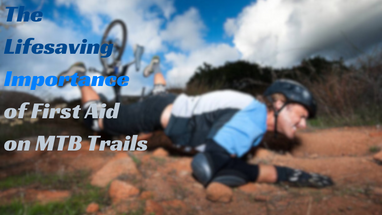Posted by Ransom Cutshall on 24th Aug 2023
The Lifesaving Importance of First Aid on Mountain Biking Trails

Picture this: you're flying down the ultimate stretch of single track, tires tearing through the loam as old growth forests rush past and rooty chatter turns your knuckles white on the handlebars. The pounding of adrenaline drowns out the noise of the wind in your ears as rock rolls give way to, sweeping berms and gravity-defying drops. While the inescapable thrill of mountain biking is undeniable, it's crucial to remember that these trails can also present unexpected (and often expected) dangers. You wouldn’t think twice about not wearing a helmet, because that level of safety is non-negotiable. But the buck doesn’t stop with the foam shell protecting your noggin, and this is where the significance of trail first aid comes into play. In this post, I will break down some of the basics around trail first aid.
Accessibility: pursuit of the gnarliest features and most pristine sections of trail will often lead you deep into the wilderness, far from immediate medical assistance. In these remote locations, accidents are bound to happen, leaving you vulnerable to injuries. Proper first aid knowledge and supplies can make the difference between getting home and being able to ride again, and potentially suffering long-term or fatal damage. From minor lacerations and abrasions to more serious broken bones or hemorrhaging, having the skills and tools to address injuries promptly and properly can prevent a manageable incident from spiraling into a life-threatening emergency.
Response time: mountain biking is an adrenaline inducing and fulfilling sport, but it's one of the more risk-prone activities we do. Unpredictable factors like changing weather, combined with assumed challenges like uneven terrain and technical challenges, can easily lead to accidents. Having treatment and stabilization options immediately on hand is vital to support the sudden nature of many mountain biking injuries. First aid training will equip you with confidence, while the right supplies will provide the tools to immediately stabilize a wound, manage pain, and provide immediate care until professional help arrives.
Minimizing complications: proper administration of first aid in the aftermath of an accident can significantly reduce the risk of complications. For example, cleaning and dressing a wound can prevent infections that might otherwise worsen due to exposure to dirt and bacteria from the trail environment. Taking swift action can also help mitigate the impact of certain injuries, potentially accelerating the recovery process, reducing long-term consequences, and getting you back out on the trail as quickly as possible.
Better the community: mountain biking is often a social activity, and hitting the trails with friends or fellow riders is one of the best ways to enjoy your local trails. Having individuals on the trail who are well-versed in first aid can make a life-saving difference. By having multiple people trained in basic first aid and carrying the right supplies, you create a supportive network that can act swiftly and efficiently to ensure the safety of a fellow injured rider. Trail first aid is extremely unique because unlike getting better at sending gaps or crushing walls, any improvement made in the field of first aid knowledge or preparedness improves every single rider out on the trails.
Boost your confidence: riding with the knowledge that you are prepared to handle unforeseen situations can significantly boost your confidence when tackling challenging obstacles. Like “bike park energy” or riding with a full face helmet, leveling up your preparedness level will allow you to push your boundaries knowing that you can respond accordingly when the rubber meets the dirt.
Be a responsible rider: would you ride without a helmet? Would you ride with someone else who chose to ride without a helmet? Responsible mountain biking involves more than just mastering the technical aspects of the sport. It also means being conscious of your impact on the environment and the safety of fellow riders. Having the knowledge to help others in need showcases your commitment to the mountain biking community and promotes a culture of safety and support.
Lead by example: your commitment to first aid on the trails can inspire others to do the same. As more riders recognize the importance of being prepared, the overall safety of mountain biking communities improves. You can become an advocate for proper training and encourage your fellow riders to invest in first aid education and supplies.
To wrap this up, the thrill of pure senditure on a mountain bike should always be accompanied by a strong commitment to safety. First aid skills and supplies can turn a potential disaster into a manageable situation. By prioritizing first aid knowledge and preparedness, you not only protect yourself but contribute to a safer and more responsible mountain biking community. So, before you hit the trails again, take the time to learn first aid and equip yourself correctly - it might just be the most valuable skill you bring along for the ride. And remember before dropping in to the next doomer, NEVER SEND IT WITHOUT YOUR MEND IT!

